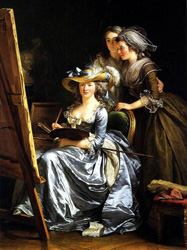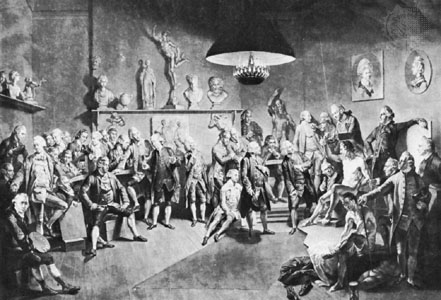
Arth Courses | ARTH 200 Assignments | ARTH 220
Eighteenth Century Women Artists:
Elisabeth Vigée-Lebrun and Adélaïde Labille-Guiard
Excerpt from Wendy Slatkin, Women Artists in History, 3rd edition, 1997, p. 103: Although she was six years older than Vigée-Lebrun, Labille-Guiard's (1749-1803) public career is contemporaneous. Unlike Vigée-Lebrun, the daughter of a painter, Labille-Guiard was born into a petit-bourgeois family with no obvious connections /p. 104: to the arts. Her skills were developed over a period of many years, and it was only in 1780, when the artist was over 30, that she exhibited her first oil paintings. Following the example set by Carriera, she learned the art of miniature painting during her adolescence from François-Elie Vincent. She then studied pastel technique with the preeminent pastel portraitist of the age, Maurice Quentin de La Tour. She only developed her skills in oil painting later, from François-André Vincent, her miniature teacher's oldest son and her future husband. She married Louis-Nicolas Guiard in 1779, lived with him for about ten years, and divorced him in 1792.
Although she had mastered the full range of techniques for portraiture by 1780, she struggled to develop a clientele. Between 1780 and 1783 she executed an uncommissioned series of portraits of preeminent Academicians, such as Vien, the teacher of David. This tactic proved to be an effective political lobbying technique to establish her abilities. She was admitted to the Academy in 1783, simultaneously with Vigée-Lebrun.
Labille-Guiard is remarkable not only for her successful career, but also for her concern and active interest in the education of women artists. After 1780, she accepted into her studio a small group of young women whom she trained. Several of her pupils continued to pursue active professional careers as portraitists. Her Self-Portrait with Two Pupils, Mlle. Marie-Gabrielle Capet and Mlle. Garreaux de Rosemond, exhibited at the Salon of 1785, is remarkable for its inclusion of two of her most capable students. Contemporary critics noted the appearance of these, as yet unknown, women artists. This painting constitutes a public introduction of the aspiring painters.
Labille-Guiard has presented herself in the costume and coiffure of the aristocracy. Documents survive indicating that, despite her Salon success of that year, she was experiencing financial difficulties. Therefore, one must interpret this proud image as a form of self-advertisement, as appeal to potential aristocratic patrons on their own terms, rather than as documentation of the artist's actual social status. This painting is characteristic of Labille-Guiard's taste for muted color harmonies, as opposed to the more highly saturated colors often used by Vigée-Lebrun. Also unlike Vigée, who favored very simplified costumes and hair arrangements, Labille-Guiard took pleasure in delineating precisely all details of the fashionable styles of her time.
According to the authoritative study of the artist, this painting was widely praised by the critical press of the day and helped to establish her reputation as a master painter in oils. The same year this work was exhibited she was awarded a substantial stipend from the king, although she was denied a studio in the Louvre due to the presence of her young female pupils. The following year she received major commissions from the royal family and worked on portraits of the "Mesdames," the aunts of the king.
The Self-Portraits of Élisabeth-Louise Vigée-Le Brun

After Johan Zoffany, The Academicians of the Royal Academy, 1772. For the identifications of the different figures see the National Portrait Gallery's page. Members of the Royal Academy are seen here around a nude male model. Since women were excluded from life drawing classes, Zoffany has included the two female members of the Royal Academy --Angelica Kauffman and Mary Moser-- as portraits hanging on the wall behind the model on the right.